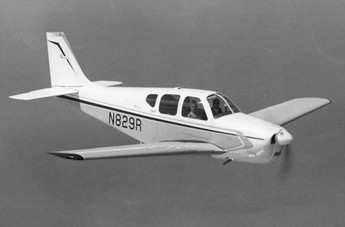'Smell' Preceded Flames
 NTSB Identification: ERA10LA210
NTSB Identification: ERA10LA210
14 CFR Part 91: General Aviation
Accident occurred Monday, April 05, 2010 in Pittsburgh, PA
Aircraft: BEECH 35-A33, registration: N156J
Injuries: 2 Uninjured.
This is preliminary information, subject to change, and may
contain errors. Any errors in this report will be corrected when
the final report has been completed.
On April 5, 2010, at 1233 eastern daylight time (EDT), a Beech
35-A33, N156J, was substantially damaged after catching fire
immediately following a low speed rejected takeoff at Allegheny
County Airport (AGC), Pittsburgh, PA. The private pilot/owner and
certificated flight instructor (CFI), were not injured. Visual
meteorological conditions prevailed, and no flight plan was filed
for the local instructional flight. The flight was conducted under
the provisions of Title 14 Code of Federal Regulations Part 91.
In an interview with the Safety Board the private pilot stated
that the purpose of the flight was for an insurance required
proficiency check that mandated 10 hours of total flight time in
aircraft make and model. He further stated that his check pilot had
flown the airplane earlier in the day and had preformed two takeoff
and landings. After the airplane had returned both pilots had went
to lunch together and upon their return they preformed a preflight
of the airplane, started the engines, received their automated
terminal information system (ATIS), and then called ground for taxi
clearance. After performing the pre-takeoff checklist in the run-up
area for runway 28, the pilot detected a smell but could not
confirm what he had smelled. After clearance for takeoff was
received from the air traffic control tower and takeoff power was
applied the pilot smelled and visually confirmed smoke coming from
the instrument panel area. He immediately aborted the takeoff at a
speed no greater than 20 knots and exited the runway at taxiway A5.
After shutting off the master and alternator switches the smoke
continued to emanate from the instrument panel; they shut down the
engine and exited the airplane onto the taxiway. They attempted to
extinguish the fire with a hand held fire extinguisher that was in
the arriving first response vehicle; however, the check pilot
observed the exterior paint located on the left side of the
airplane, near the area between the instrument panel and firewall,
began to blister. The Airport Rescue and Fire Fighting extinguished
the fire within a few moments of their arrival; however, the
airplane cabin area had been consumed by fire.
The pilot also stated that the airplane was owned by the
Pittsburg Institute of Aeronautics, and that the college had
purchased the airplane approximately six months prior to the
accident. The airplane logbooks had been lost prior to their
purchase of the airplane and the college had attempted to
reconstruct the logbooks. They had completed all of the required
annual inspections on the airplane. He also stated that they had
not done any work on the avionics or wiring of the airplane since
they purchased the airplane.

File Photo
According to the pilot and Federal Aviation Administration (FAA)
records he held a private pilot certificate with ratings for
airplane single-, multi-engine land, and instrument airplane. His
most recent FAA third-class medical was issued on May 11, 2009 and
at the time of the accident he had accrued 387 total hours of
flight experience and no hours in the accident airplane make and
model.
According to FAA records the CFI held an airline transport pilot
certificate with a rating for airplane single-engine land, a
commercial pilot certificate with ratings for airplane multiengine
land, rotorcraft-helicopter, glider, and lighter-than-air free
balloon, and a flight instructor certificate with ratings for
airplane single-, multi-engine, instrument airplane, and glider.
His most recent FAA second-class medical was issued in April, 2009
and at that time he reported 25,000 total hours of flight
experience.
The airplane was a Beech 35-A33 manufactured in 1961. It was
equipped with a Continental Motors IO-470-J series engine and a
Hartzell propeller. It was a high performance, all-metal, low-wing,
single-engine cantilever monoplane with fully retractable tricycle
landing gear.
The 1253 recorded weather observation at AGC, included winds
from 250 degrees at 10 knots with gust of 25 knots, broken clouds
at 4,900 feet and 6,000 feet above ground level, 10 miles
visibility, temperature 23 degrees C, dew point 12 C, and an
altimeter setting of 30.02 inches of mercury.
The airport was served by an FAA Air Traffic Control Tower at
the time of the accident. It also had two crossing runways
designated 10/28 and 13/31. The accident flight was departing off
of runway 28 which was a 6,501-foot-long and 150-foot-wide concrete
runway. Taxiway A5 was located approximately 334 feet from the
beginning of the accident flight takeoff roll.
The airplane aft of the firewall including the cabin area and
roof structure was consumed by fire. Examination of the wreckage by
the FAA discovered that the source of the fire began on the left
side of the instrument panel in the vicinity of the communication
radios, circuit breaker, and electrical bus bar.
 ANN's Daily Aero-Linx (04.16.24)
ANN's Daily Aero-Linx (04.16.24) Aero-News: Quote of the Day (04.16.24)
Aero-News: Quote of the Day (04.16.24) Airborne 04.10.24: SnF24!, A50 Heritage Reveal, HeliCycle!, Montaer MC-01
Airborne 04.10.24: SnF24!, A50 Heritage Reveal, HeliCycle!, Montaer MC-01 Airborne 04.12.24: SnF24!, G100UL Is Here, Holy Micro, Plane Tags
Airborne 04.12.24: SnF24!, G100UL Is Here, Holy Micro, Plane Tags Airborne-Flight Training 04.17.24: Feds Need Controllers, Spirit Delay, Redbird
Airborne-Flight Training 04.17.24: Feds Need Controllers, Spirit Delay, Redbird




